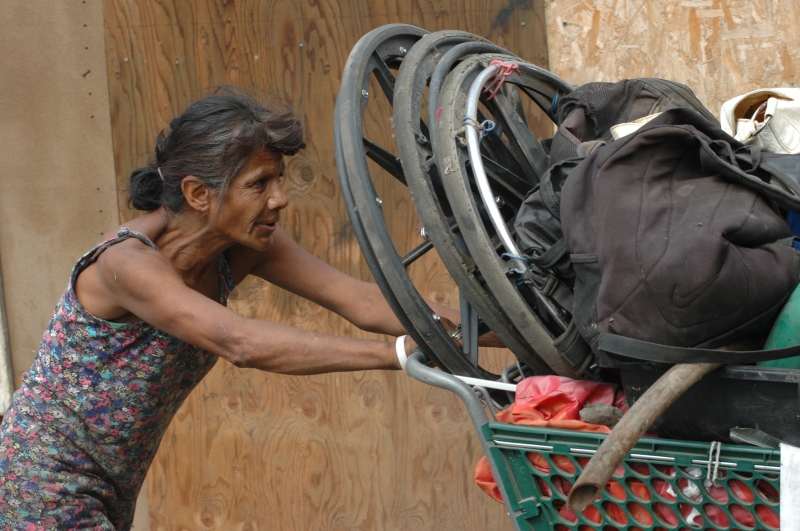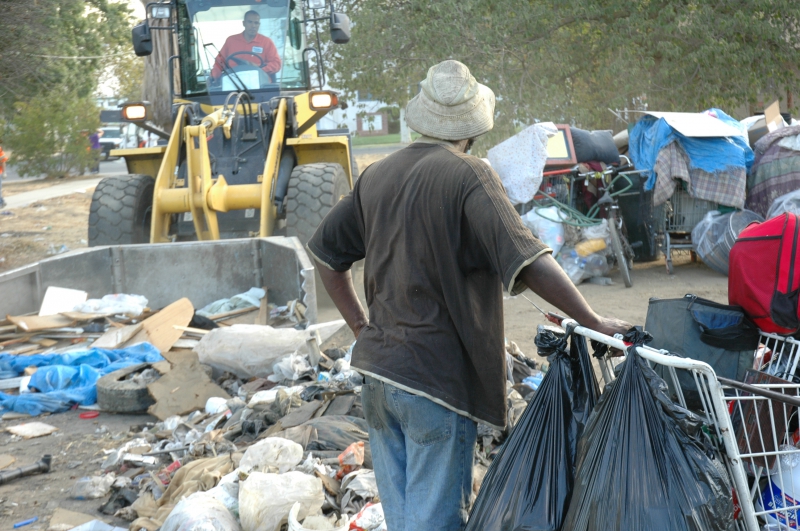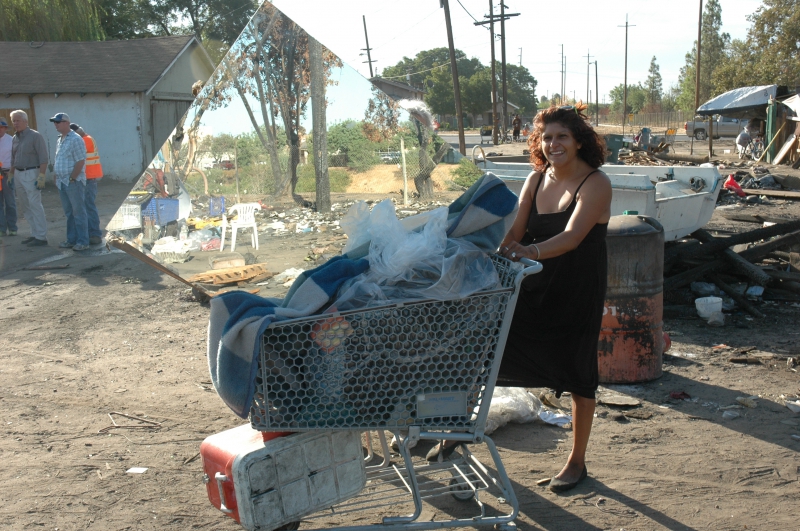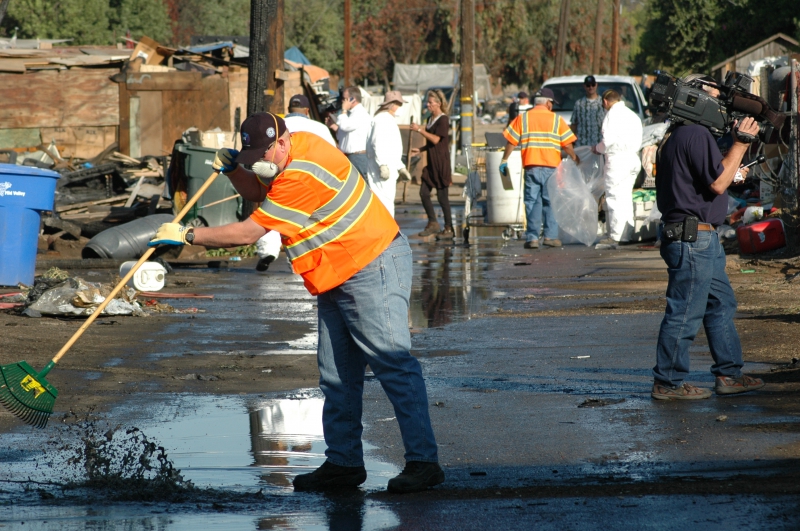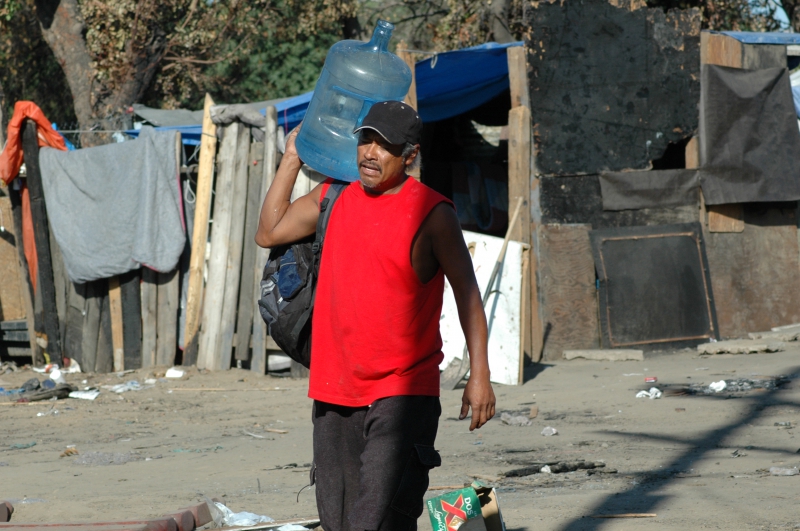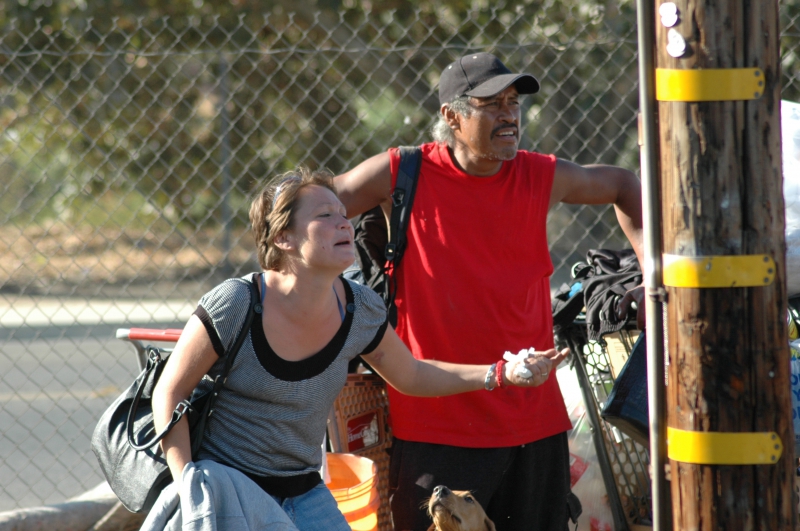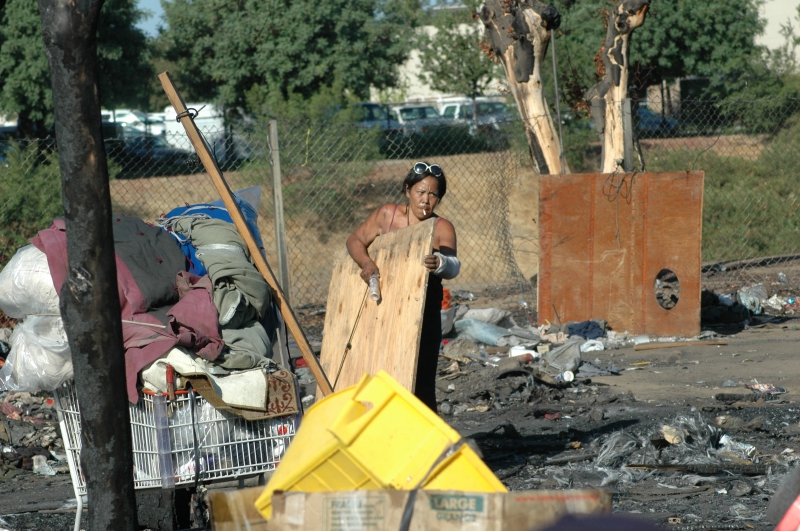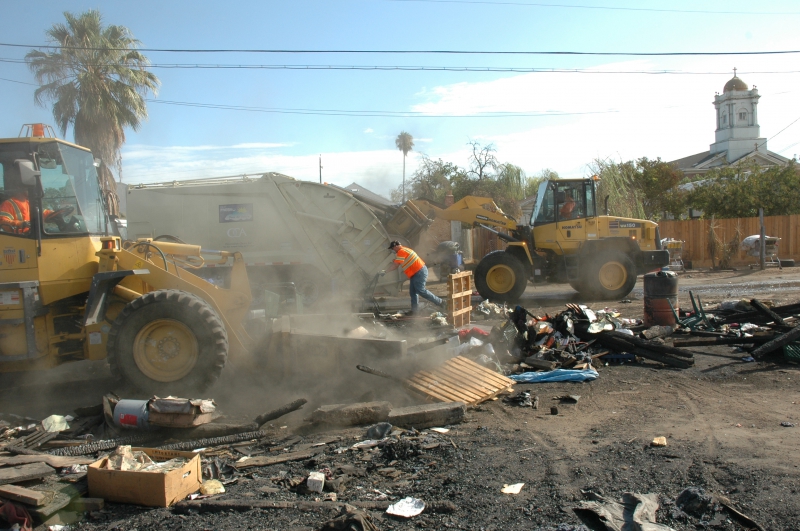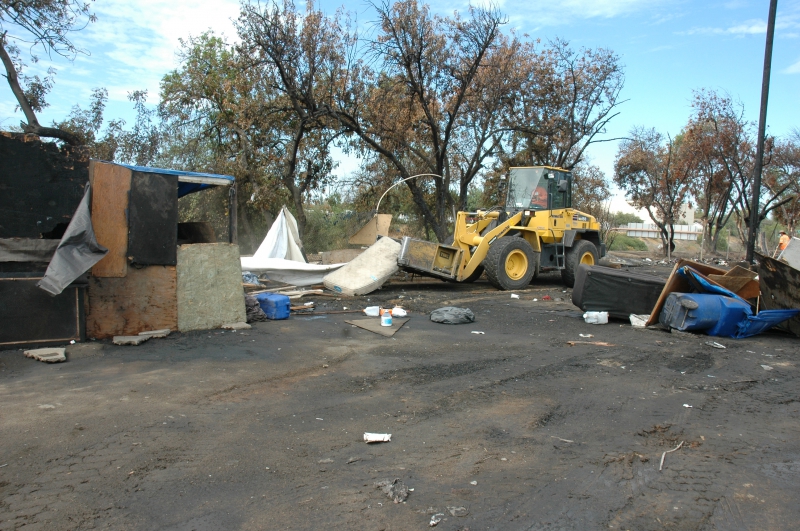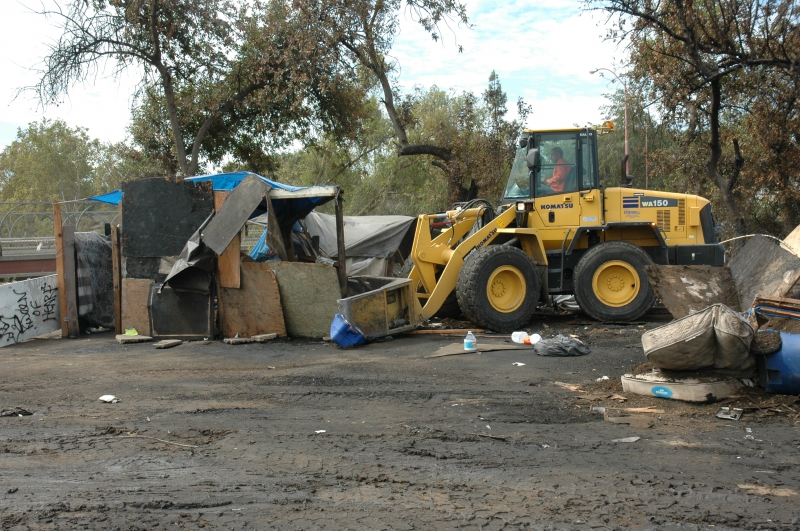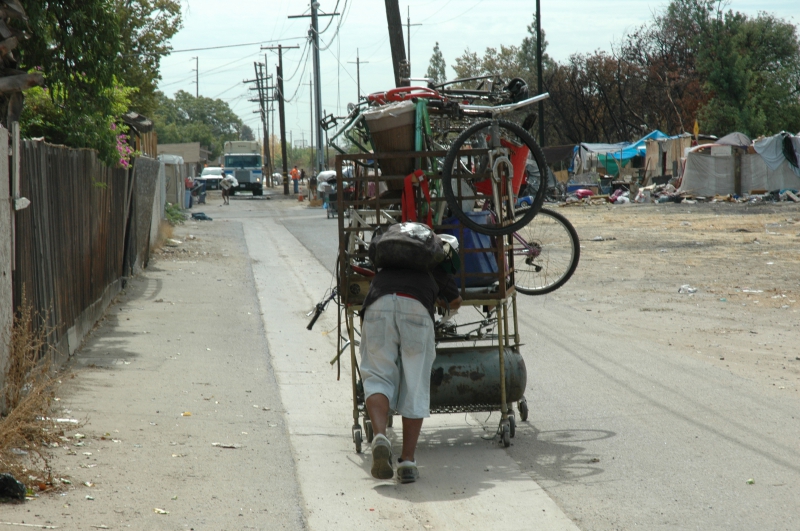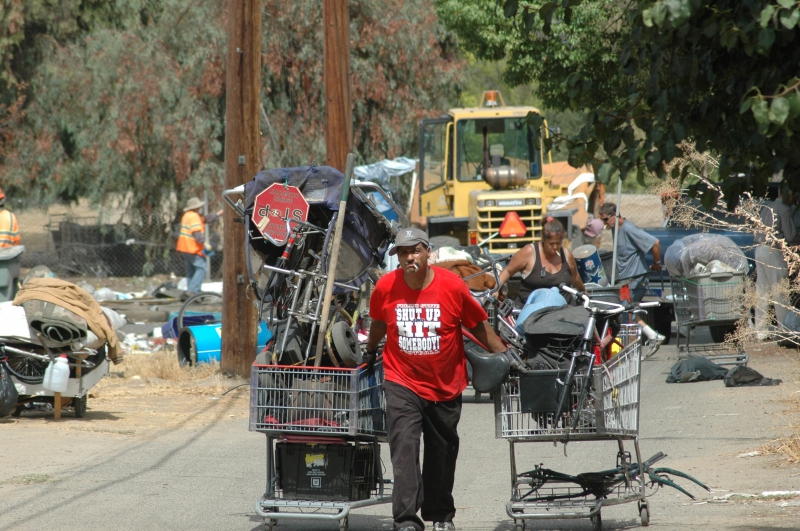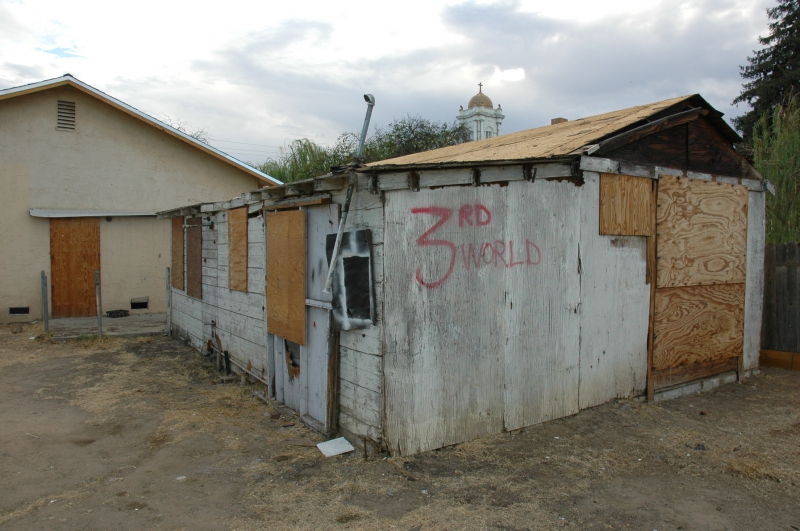The relentless assault on American Labor has resulted in record numbers of homeless people.

According to the Economic Policy Institute if the minimum wage had kept pace with the productivity growth over the last 35 years as it did for the twenty years prior to 1968 the minimum wage would be $18.67 per hour and the median wage would be $28.42 per hour instead of the $16.30 per hour workers currently receive. (1)
That extra $11.42 and $12.12 per hour of productivity went somewhere, where?
CEO pay grew 127 times faster than worker pay over the last 30 years despite workers doubling productivity over that same time period. (2)
Income for the top 20 percent of American workers has increased since the 1970s while income for the bottom 80 percent declined. In the 1970s the top 1 percent received 8% of total income while today they receive 18%. During the same period income for the bottom 20% had decreased 30%.
In the 1970s the top 0.1 % of Americans received 2 percent of total income. Today they get 8%.
In 1980 the average CEO made 50 time more money than the average worker while today the average CEO makes almost 300 time more than the average worker. (3)
49.7 million Americans live in poverty. (4)
From one end of the nations to the other, American cities are dealing with an inadequate supply of housing for the working class by sending those who fall off the bottom rung to jail or shelters. Many shelters are shelters in name only and are more reflective of a nighttime jail.
Which one is the shelter and which one is the jail?


Tampa Florida enacted a law a few weeks ago that makes it illegal to sleep or store personal belongings in public. (5)
Columbia South Carolina has criminalized the presence of homeless people in downtown while Palo Alto, California recently outlawed the use of vehicles by homeless individuals. (6) (7)
Being forced into shelters of substandard living conditions has a lot more in common with the segregation laws of the 1950s south and the Japanese Internment Camps during World War II. (8)
The general tune that you hear from homeless service providers, policy makers and the justice system is that people are homeless because they have substance abuse problems and or mental health issues. This belief allows policy makers to blame homeless people for their circumstances while simultaneously avoiding the true cause of homelessness, a lack of housing.
26.2 percent, 79 million, of Americans suffer from mental illness and 6 percent, 18 million, of Americans suffer from serious mental illness. (9) The 26.2% mental illness rate for all Americans was the same for those who were homeless across the nation on a given night in January 2010. (10)
More than 22 million Americans age 12 and older – nearly 9% of the U.S. population – use illegal drugs, according to the government’s 2010 National Survey on Drug Use and Health. (11) (12)
44%, 137 million, of Americans drink alcohol at least once a week. (13) 15% of the people living in the United States, 47 million Americans, are considered “problem drinkers,” according to the National Institutes of Health. (14)
34.7% of all sheltered adults who were homeless had chronic substance use issues which are higher than the 24% of the general population yet it is theorized that many people who do not suffer from substance abuse problems actually develop one as a result of and response to being homeless. Thus the increase in substance abuse in the homeless population is directly related to the difficulties and despair of being homeless. (15)
There are only 1,600,000 people who endured a night of homelessness in 2009/2010. On a single day in January 2012, 633,782 people were experiencing homelessness. Only 110,000 people suffer from chronic homelessness. (16)
If the primary reason why people become homeless was the result of mental illness and or substance abuse then there would be a minimum of 30 million people suffering homelessness in America yet there is at most 1,600,000 who endured one night of homelessness over the course of a year with the current daily average being 633,782.
According to the Substance Abuse and Mental Health Services Administration most Americans who are illicit drug users, 9.4 million in 2004, or heavy alcohol users, 10.6 million in 2004, also hold full-time jobs. (17) This statistic obliterates the argument that people are homeless due to their own self-destructive decisions from mental health issues or of abusing mind altering substances.
125,000 families that are currently housed are at risk of becoming homeless not because of mental illness, drug or alcohol abuse but because of nation wide cuts to the federal Section 8 housing voucher program. (18)
“Because rents are so high, many of these families may, quite literally, find themselves out on the street as a result of these arbitrary budget cuts,” Stephen Norman, executive director of the King County Housing Authority, Washington State (19)
So in places like Columbia South Carolina, Tampa, Florida and Palo Alto, California people could literally go from an apartment to the street and then to jail because the government has removed them from the Section 8 rental assistance program.
If it weren’t for mom and dad allowing their grown children to live at home there could easily be 1.5 million more young adults who do not have a mental illness or substance abuse problem living on the streets subject to arrest for simply being homeless. (20)
If people are not homeless because of mental illnesses and substance abuse then why are they homeless? Why do the homeless service providers, policy makers and law enforcement promote these erroneous reasons to the public as the cause of homelessness?
Answers, people are homeless because there is a shortage of housing created on purpose to maximize property values and the homeless service providers, policy makers and law enforcement industries all have a monetary incentive to create more homeless people not less. By promoting these fallacies the special interest groups can mold public opinion away from the solution that would eliminate the vast majority of homelessness.
“In early 1984 on Good Morning America, Reagan defended himself against charges of callousness toward the poor in a classic blaming-the-victim statement saying that “people who are sleeping on the grates…the homeless…are homeless, you might say, by choice.” (21)
Anywhere from 30% to 44% of homeless people have a job, thus being unemployed isn’t the cause of homelessness necessarily. (22)
In the 1980s the proportion of the eligible poor who received federal housing subsidies declined. In 1970 there were 300,000 more low-cost rental units (6.5 million) than low-income renter households (6.2 million). By 1985 the number of low-cost units had fallen to 5.6 million, and the number of low-income renter households had grown to 8.9 million, a disparity of 3.3 million units. (23)
The cost of an emergency shelter bed funded by HUD’s Emergency Shelter Grants program is approximately $8,067 more than the average annual cost of a federal housing subsidy (Section 8 Housing Certificate). A recent HUD study found that the cost of providing emergency shelter to families is generally as much or more than the cost of placing them in transitional or permanent housing. (24)
The un-housed spend more time in jail or prison than the housed, which is tremendously costly to counties and states. Often, time served is a result of laws specifically targeting the homeless population, including regulations against loitering, sleeping in cars, and begging. Additionally since the homeless do not have private residences to drink alcohol upon as most people do they are disproportionally arrested for drinking in public compared to the general population.
Dr. Pamela Fischer, of Johns Hopkins University, studied the 1983 arrest records in Baltimore and found that homeless people are actually less likely to commit crimes against persons or property than housed people but more likely to commit non-violent and non-destructive crimes like loitering, sleeping in cars and parks, drinking in public, begging etc…(25)
A University of Texas study revealed that it costs $14,480 per year to house a homeless person in jail and $20,000 per year in prison. (26)
Next door to Palo Alto is San Mateo County that is attempting to obtain public funds to build a new jail that will house 576 to 832 people at a minimum cost of $165 million to build yet is likely to double to $330 million as a result of issuing bonds to finance the project. (27)
We need to house all those homeless people somewhere.
China’s population is 1.344 billion and incarcerates 1,548,498 citizens, 118 people for every 100,000 citizens. The United State’s population is 313million and incarcerates 2,193,798 citizens, 737 people for every 100,000 citizens. (28)
The extensive homeless population is the collateral damage of a faulty housing market and corrupted economic regulations. These deleterious institutions are the mines that produce the human fuel for the prison industry as well. In 2008
approximately one in every 31 adults (7.3 million) in the United States was behind bars, or on probation and parole. (29)
 Over $74 Billion dollars a year is spent on the prison system. (30) It costs approximately $47,102 per year to incarcerate one person in a California prison. (31) It costs U.S. tax payers $9 billion a year to feed, house and clothe the people who are in jail waiting for trial who cannot afford bail. (32)
Over $74 Billion dollars a year is spent on the prison system. (30) It costs approximately $47,102 per year to incarcerate one person in a California prison. (31) It costs U.S. tax payers $9 billion a year to feed, house and clothe the people who are in jail waiting for trial who cannot afford bail. (32)
Why all this information on the prison system? Because the faulty economic system that produces the majority of inmates is same faulty economic system that has produced the increased homeless population. The judicial, jail and prison system is a $100 billion dollar industry and those that benefit financially form it: bail bondsman; deputy sheriffs; prison guards; construction companies; doctors; lawyers; etc… do not want to upset the apple cart by resetting the economy to ensure that most Americans can earn a good living.
It is this same conflict of interest that prevents people who earn a living from the homeless service provider industry from criticizing the policy makers regarding the faulty housing market and corrupted economic system.
Homeless service providers receive much of their funding from the government and wealthy interest groups, interest groups that are the ones actually directing policy makers in government to enact certain laws and policies that benefit them financially.
If a homeless service provider were to publicly criticize the policy makers for failing to produce enough housing the policy makers and private interests will withhold funding from that homeless service provider and give it to another service provider who is willing to go along with the program.
Additionally, if enough housing were created the majority of the homeless population would disappear on its own rendering the homeless service providers as an obsolete and unnecessary industry. Hence, the reasons why the homeless service providers continue to promote the fallacy of mental health/drug use as the primary causes to homelessness is to perpetuate their gravy train job security.
“We’re pretty good about not talking about income inequality,” Sheldon Danziger, a University of Michigan public policy professor. (33)
“There’s class warfare, all right, but it’s my class, the rich class, that’s making war, and we’re winning.” Warren Buffett
The federal government’s multi-agency approach to help the homeless is often confused, according to a recently released report that catalogues the hundreds of different ways the government squanders taxes through waste, overlap, fragmentation and bureaucracy.
The Government Accountability Office report found that in 2009, federal agencies spent about $2.9 billion on more than 20 programs that targeted homelessness. If that money were to be targeted toward the building of homes, at say, $200,000 per home, it could theoretically produce 145,000 houses. (34)
The two above industries, law enforcement/incarceration and service providers are small potatoes compared to the one which is directly responsible for the plethora of homeless and that is the real estate industry as a whole. Property owners whether they be large corporations or the young couple who owns a single home have an inherent conflict of interest to producing a large supply of housing in close proximity to their low paying jobs when those low pay jobs exist in close proximity to expensive real estate.
The corporations and apartment owners are seeking to maximize lease amounts while the young couple wants to see the value of their house rise at an absurd rate to create a quick and substantial profit demonstrating that both have an inherent conflict of interest to producing a large supply of housing.
 It is a case of supply and demand economics. The housing market keeps the supply of housing low which creates a high demand and thereby enables the property owners to charge renters more money increasing profits. In the case of home owners what historically was a lifetime investment is now a mechanism by which to sell for a profit within a few years and anything that would derail such a goal is to be squashed.
It is a case of supply and demand economics. The housing market keeps the supply of housing low which creates a high demand and thereby enables the property owners to charge renters more money increasing profits. In the case of home owners what historically was a lifetime investment is now a mechanism by which to sell for a profit within a few years and anything that would derail such a goal is to be squashed.
Federal Minimum Wage: Pay before taxes (40hrs per week)
1965 1.25 $200 per month
1970 1.60 $256 per month
1975 2.10 $336 per month
1980 3.10 $496 per month
1990 3.80 $608 per month
2000 5.15 $824 per month
2010/11 7.25 $1,160 Per month
One bedroom Apartment in Palo Alto
1965: $87.50 to $130.00
1970: $115.00 to $165.00
1975: $125.00 to $150.00
1980: $385.00 to $400.00
1990: $600.00 to $775.00
2000: $1,200.00 to $1,600.00
2011: $1,100.00 to $1,650.00
Percentage of a Single Person’s Minimum Wage Income Used On Housing Cost
In 1965 43.5% to 65.0% of income to Housing Cost
In 1970 44.9% to 64.4% of income to Housing Cost
In 1975 37% to 44.6% of income to Housing Cost
In 1980 77.6% to 80.% of income to Housing Cost
In 1990 98.8% to 127.4% of income to Housing Cost
In 2000 145.6% to 194.0% of income to Housing Cost
In 2010/11 94.8% to 142.2% of income to Housing Cost
The Extortion of the Poor:
A studio in Palo Alto typically goes for $1,400 a month in 2013. Retail and grocery jobs generally pay $12.00 per hour if you’re lucky which equates to $2,100 a month before taxes. After deducting federal and state taxes that amounts to roughly $1,900 a month which leaves $500 for food, health care and other expenses.
A person, John, is giving 74% of his/her income to a property owner just to have a box to sleep in. Thirty hours of this person’s work week produces John zero lasting capital.
What does John do in response to being forced to hand over the fruit of his labor to someone else solely because the other person owns all of the land and refuses to build more housing, John moves into his van to keep the $1,400 for himself. So what does the property owners and local business community do in response to John moving into his van to keep his hard earned money for himself, the property owners and business leaders lobby the local policy makers to make it illegal to sleep/live in a vehicle and thereby force John to move back into a wooden box and to hand over the majority of the fruit of his labor to the property owner, a person who has more money than he knows what to do with.
In any other circle we would call the above act extortion.
Duke Grad Student Lives in Van to Save Money:
In order to maintain their erroneously inflated property value and high rents property owners rely on the government to make up the difference between the underpaid worker or disabled person and the cost of rent through the Section 8 voucher program.
Due to a 1% vacancy rate the average one-bedroom apartment in Santa Clara County goes for $1,700 a month. The current cap on the Section 8 voucher for Santa Clara County is $1,315 for a one bedroom which is considered the fair market rate but not necessarily what the market will bear. This means that if a person finds an apartment for $1,315 the government will pay the landlord $854.75 while the tenant on the program will pay $460.25. (35)
If there was a enough housing in Santa Clara County to create a 10% to 15% vacancy rate the cost of an average apartment could conceivably drop to $800 a month with the low end being around $500 a month. This would enable the vast majority of people who rely on the Section 8 program to leave the program saving the government, tax payers, millions of dollars locally and billions of dollars nationally.
So the question is, why do we as a society refuse to demand larger supply of housing a surplus of housing?
Increasing the minimum wage to $20.00 per hour will not solve the problem of affordable housing if the housing supply is not correspondingly increased as well. If the minimum wage were increased 275% to $20.00 per hour the property owners would in turn increase their rents 275% negating any gain by the workers. The gains in productivity would be shifted from the corporations through the workers and to the property owners resulting in zero benefit to the American worker.
Franklin Roosevelt, Lyndon Johnson, Harry Truman, Bill Clinton and even Richard Nixon and George W. Bush acknowledged that private housing markets fail the poor by not providing housing for people with low incomes.
A caveat should be made regarding Homeless Service Providers. The criticism directed toward Homeless Service Providers is strictly to those organizations whose budgets are bloated with staff salaries producing minimal impact at reducing the root causes of homelessness. There are many local and national organizations that truly help the homeless lessening the difficulties and hardships incurred by the homeless without seeking self enrichment off of the existence of homelessness and without compromising the fundamental values of fairness in the economy and housing markets for self preservation.
What’s the Solution?
What do all of the pundits like to say, “we’ll you’re good at criticizing but you don’t provide any solutions.” Well to satiate all
of the pundits, here is at least one feasible solution.
There is one significant solution to homelessness and the exploitation of the American worker and that is to shrink the difference between income and the cost of housing. The only way to shrink the gap between pay and housing cost is to increase the supply of affordable housing. Attempting to solve the homeless problem without decreasing the housing costs of the 49 million Americans living in poverty will be a fruitless effort.
Palo Alto is a magnified microcosm problem of what is going on around the country from San Francisco to Tampa, Florida.
‘The people who worked in the retail shops and grocery stores in Palo Alto in 1975 used to be able to afford a studio or one bedroom apartment in Palo Alto without requiring any government subsidization. If these people were enabled to secure housing in the town they work in by providing a surplus of affordable housing then the working poor would no longer need government housing assistance freeing that assistance up for the homeless who do not have jobs and or are disabled.
There are a number of people in Palo Alto who claim that if a person cannot afford to live in Palo Alto they need to move elsewhere even is said person works in Palo Alto. The problem with that argument is that the cost of housing in the twenty miles adjacent to Palo Alto is not much different than Palo Alto. When you factor in the cost of commuting upon those who can least afford to commute to work what little might be saved by living 30 to 40 miles away from Palo Alto would actually result in a greater cost than living in Palo Alto without commuting.
“What the Market will bear.” The problem with that assertion is that the Market is not bearing requiring the government to step in and provide food stamps and housing vouchers to people who are working full-time.
The policy makers, homeless service providers and law enforcement have to blame the homeless for being homeless because if they didn’t then they would be forced to address the true cause of homelessness and that is the exploitation of American through the use of a housing shortage.
The policy makers created the problem of homelessness through implementing bad policy in order to maximize profits for special interests. Now that there is a homeless problem instead of implementing the solution, creating more housing, the policy makers would rather criminalize the homeless so that more special interests, the justice system and homeless service providers can make a gravy train living.
If people could go to work and reap the majority of the fruit of their labor without having to hand it over to property owners would these people have more reasons or fewer reasons to commit crimes? If the homeless drunk was not drunk in public but on private property he wouldn’t be cited for being drunk in public.
By increasing a surplus of decent and affordable housing even if it requires the government to step in with money the
government will save money in the end due to the reduction in jail and prison costs plus there is the immeasurable benefit of reducing the number of victims of crime.
With a significant reduction of crime, hundreds of thousands of attorneys, prosecutors/defense attorney will no longer be needed. These attorneys use their connections to with the policy makers to ensure that their industry stays afloat through economic oppression and exploitation.
The current mindset in America is that if you work in a grocery store you don’t deserve to bear the fruit of your labor. It is this mindset that needs to be flipped on its head.
The average American male has the ability to go into the woods, chop down some trees and create a very nice log cabin in three to six months of work. Once his cabin is complete he no longer has to work on it and is now free to pursue all the other necessities of life and personal objectives. This is how it should be for this is how it was.
In 1965 it took 4.5 years’ salary of a custodian to purchase a 2 bedroom house in Palo Alto, California.
In 1975 it took 8.5 years’ salary of a delivery driver to purchase a 3 bedroom house in Palo Alto, California.
In 2011 it takes it takes 40 to 54 years’ salary of a delivery driver to purchase a 3 bedroom house in Palo Alto, California. (40)
If Abraham Lincoln were forced to work 30 to 40 hours a week on his cabin year after year then he would not have had the time to become an attorney. If Lincoln did not become an attorney he would have never become President. If he had not become President then he would have never issued the Emancipation Proclamation. Lincoln was liberated from the slavery of housing so that he could liberate an entire race.
Some where along the way the property owners convinced the policy makers that people should have to work 30 hours a week on their housing indefinitely. They have accomplished this by manipulating the housing economy into making housing much more expensive then it needs to be or should be. By artificially making housing more expensive than what most people are capable to pay off in a few years the property owners have shackled the low wage earners to working on their housing for the entirety of their lives unnecessarily.
This is theft. This is extortion. This is slavery.
 It is time that the policy makers liberate the 100 million Americans who are enslaved to property owners. In the 1800s they picked cotton, today they pour coffee and stock your produce.
It is time that the policy makers liberate the 100 million Americans who are enslaved to property owners. In the 1800s they picked cotton, today they pour coffee and stock your produce.
Every person should be able to afford a decent place to live in the town and or city that they work.
The State of California already actually does this through the Housing Accountability Act Government Code Section 65580-65589.8. (41)
However there is no teeth to the law which enables city’s like Palo Alto to avoid providing housing for every person who works in its city forcing the low income workers to live as many as twenty miles away.
Section 8 housing just enables the property owners to maintain their unnecessary exorbitant rent.
I’m sure there are other formulas that would be more appropriate and work better however here is one as an example for food for thought.
Housing Mandate:
Every city and or town shall provide a 5% surplus of housing based upon the number of jobs each city/town produces that pay the federal minimum wage up to 30% of each city’s/town’s median income separated into four average income levels as follows:
ONE: Each city/ town shall produce a 5% surplus of housing for the total number of jobs within said city/town paying the federal minimum wage at full-time at a cost not to exceed 25% of the federal minimum wage paid out for full-time work, which is 166 hours a month;
TWO: Each city/town shall produce a 5% surplus of housing of the average income of the bottom 5% of income earners based upon the jobs produced within each city’s/towns boundaries at a cost not to exceed 25% of the average of the bottom 5% of income earners within each city’s/town’s boundaries based upon full-time work which is 166 hours a month;
THREE: Each city/town shall produce a 5% surplus of housing of the average income of the bottom 5.1% to the bottom 10% of income earners based upon the jobs produced within each city’s/towns boundaries at a cost not to exceed 25% of the average of the bottom 5.1% to 10% of income earners within each city’s/town’s boundaries based upon full-time work which is 166 hours a month;
FOUR: Each city/town shall produce a 5% surplus of housing of the average income of the bottom 10.1% to the bottom 15% of income earners based upon the jobs produced within each city’s/towns boundaries at a cost not to exceed 25% of the average of the bottom 10.1% to 15% of income earners within each city’s/town’s boundaries based upon full-time work full-time work which is 166 hours a month;
FIVE: Each city/town shall produce a 5% surplus of housing of the average income of the bottom 15.1% to the bottom 20% of income earners based upon the jobs produced within each city’s/towns boundaries at a cost not to exceed 25% of the average of the bottom 15.1% to 20% of income earners within each city’s/town’s boundaries based upon full-time work full-time work which is 166 hours a month;
SIX: Each city/town shall produce a 5% surplus of housing of the average income of the bottom 20.1% to the bottom 25% of income earners based upon the jobs produced within each city’s/towns boundaries at a cost not to exceed 25% of the average of the bottom 20% to 20.1% of income earners within each city’s/town’s boundaries based upon full-time work full-time work which is 166 hours a month;
SEVEN: Each city/town shall produce a 5% surplus of housing of the average income of the bottom 25.1% to the bottom 30% of income earners based upon the jobs produced within each city’s/towns boundaries at a cost not to exceed 25% of the average of the bottom 25.1% to 30% of income earners within each city’s/town’s boundaries based upon full-time work full-time work which is 166 hours a month.
For Example:
A) If the average income of the bottom 5% of the median income of Palo Alto job earners is $1,700.00 per month and there are 1,000 jobs in Palo Alto that make up this income bracket then Palo Alto will need to provide 1,050 units of housing that cost no more than $425.00 per month.
B) If the average income of the 5.1% to 10.0% of the median income of Palo Alto job earners is $2,400.00 per month and there are 1,000 jobs in Palo Alto that make up this income bracket then Palo Alto will need to provide 1,050 units of housing that cost no more than $600.00 per month.
C) If the average income of the 25.1% to 30.0% of the median income of Palo Alto job earners is $3,600.00 per month and there are 1,000 jobs in Palo Alto that make up this income bracket then Palo Alto will need to provide 1,050 units of housing that cost no more than $900.00 per month.
Should any city/town fail to produce the above housing supply for its residents said city will be subject financial penalties which shall include but not be limited to federal conservatorship enabling eminent domain action to take place in order to secure the minimum housing requirements.
The excess in housing will drive down the cost of all other housing and open up housing for those homeless people who are on fixed incomes and or disability.
Mark Johnston, the acting assistant housing secretary for community planning and development, estimated that homelessness could be eliminated for a cost $20 billion annually. The housing department’s budget for addressing homelessness is currently about $1.9 billion. (37)
$20 billion is slightly less money than Americans spend on Christmas decorations, according to an analysis from ThinkProgress. (38)
National Security:
Cost of the War in Afghanistan: $654 billion
Cost of the War in Iraq: $814 billion
Money spent on Department of Defense for 2013 and counting: $488 billion
Money Spent on Homeland Security Since 9/11: $712 billion (39)
If we were to redefine Homelessness as a National Security Risk then $20 billion would look like a bargain.
SOURCES:
(1) (2) (3) (3B) (4) (5) (6) (7) (8) (9) (10) (11) (12) (13) (14) (15) (16) (16B) (16C) (17) (18) (19) (20) (21) (22) (22B) (22C) (23) (24) (25) (26) (27) (28) (29) (30) (31) (32) (33) (34) (35) (36) (37) (38) (38B) (39)
(40) Palo Alto Housing Costs:
In 1965 a 2 bedroom house cost $23,000.00
In 1965 a 4 bedroom house cost $36,000.00
In 1965 a Machinist earned $8,500.00 a year
In 1965 a Custodian earned $5,100.00 a year
A Machinist’s yearly salary was 37% of the cost of a 2 bedroom house.
A Machinist’s yearly salary was 23.6% of the cost of a 4 bedroom house.
A Custodian’s yearly salary was 22% of the cost of a 2 bedroom house.
A Custodian’s yearly salary was 14% of the cost of a 4 bedroom house.
In 1975 a 3 bedroom house cost $61,000.00
In 1975 a Delivery Driver earned $7,200.00
A Delivery Driver’s yearly salary was 11.8% of the cost of a medium quality house.
In 2011 a 3 bedroom house costs $1,200,000.00
In 2011 a Delivery Driver earned $22,000.00 to $30,000.00 a year
A Delivery Driver’s yearly salary is 1.8% to 2.5% of the cost of a low-end quality house.
A person’s yearly income of the cost of an average house in Palo Alto went from 22% to 11.8% to 2.5% of in the last 45 years.
References: The “Palo Alto Times,” the “Palo Alto Times-Tribune,” the “Palo Alto Weekly,” and “Craigslist”
(41) California Government Code: 65589.5. (a) The Legislature finds and declares all of the following:
(1) The lack of housing, including emergency shelters, is a critical problem that threatens the economic, environmental, and social quality of life in California.
(2) California housing has become the most expensive in the nation. The excessive cost of the state’s housing supply is partially caused by activities and policies of many local governments that limit the approval of housing, increase the cost of land for housing, and require that high fees and exactions be paid by producers of housing.
(3) Among the consequences of those actions are discrimination against low-income and minority households, lack of housing to support employment growth, imbalance in jobs and housing, reduced mobility, urban sprawl, excessive commuting, and air quality deterioration.
(4) Many local governments do not give adequate attention to the economic, environmental, and social costs of decisions that result in disapproval of housing projects, reduction in density of housing projects, and excessive standards for housing projects.
65580. The Legislature finds and declares as follows:
(a) The availability of housing is of vital statewide importance, and the early attainment of decent housing and a suitable living environment for every Californian, including farmworkers, is a priority of the highest order.
(b) The early attainment of this goal requires the cooperative participation of government and the private sector in an effort to expand housing opportunities and accommodate the housing needs of Californians of all economic levels.
(c) The provision of housing affordable to low- and moderate-income households requires the cooperation of all levels of government.
(d) Local and state governments have a responsibility to use the powers vested in them to facilitate the improvement and development of housing to make adequate provision for the housing needs of all economic segments of the community.
COMPLETE CODE HERE: 42
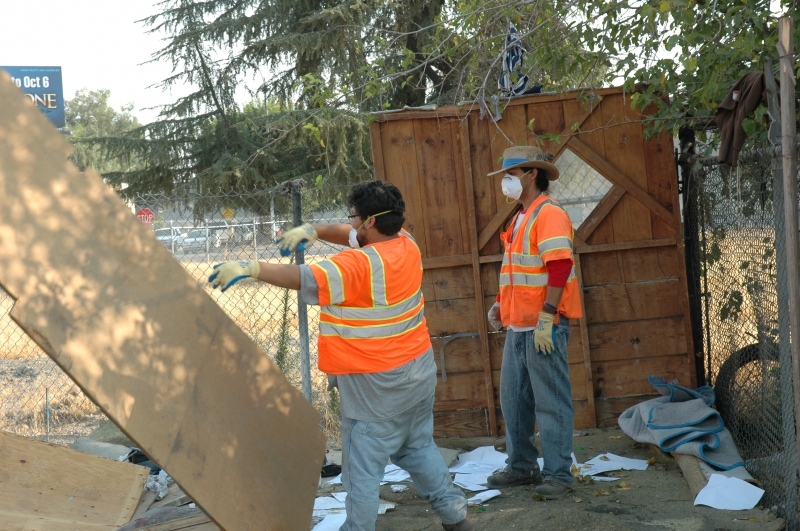
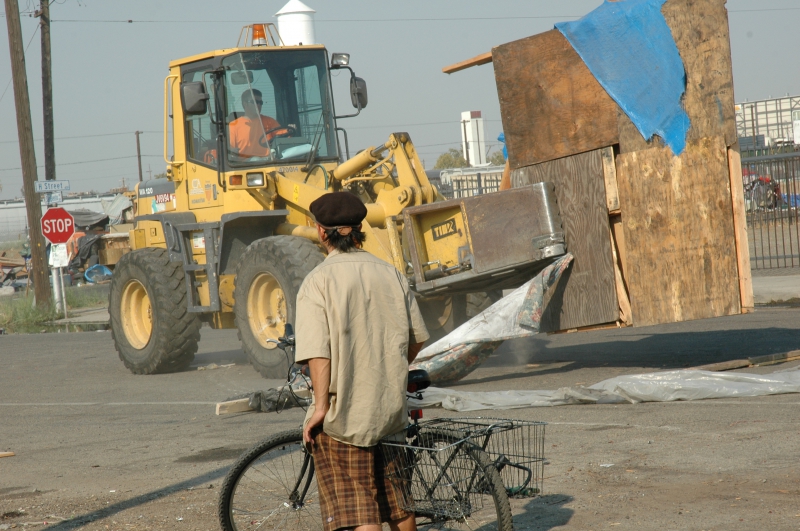
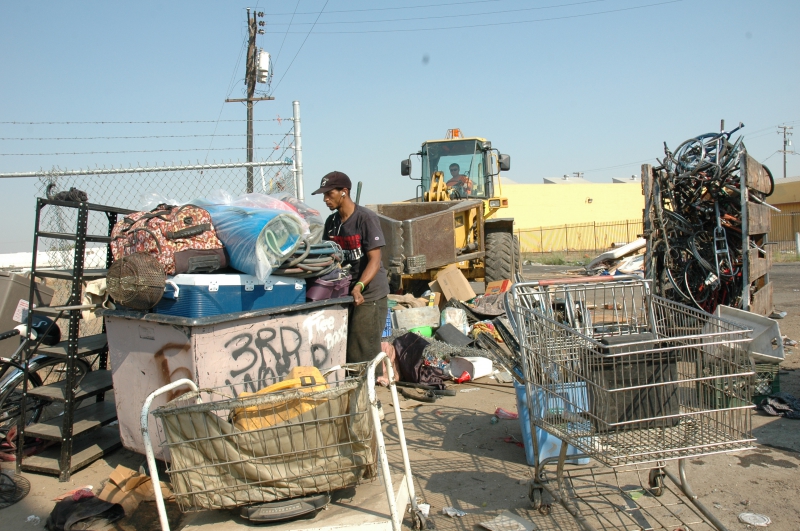
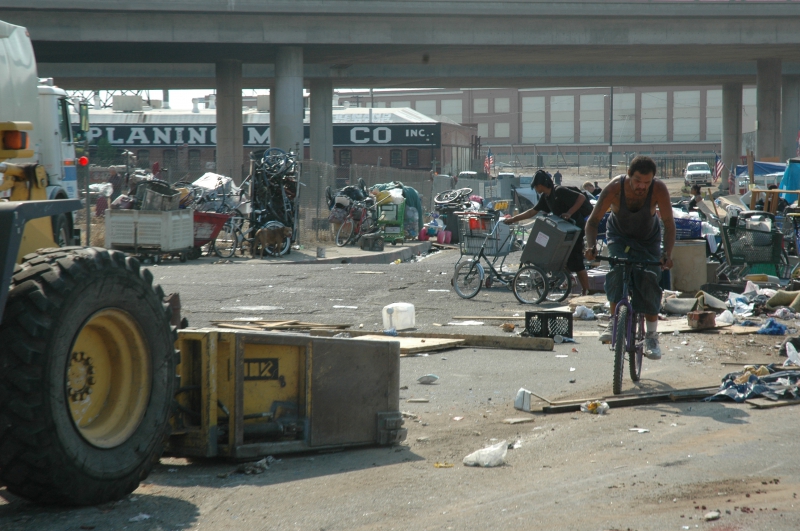
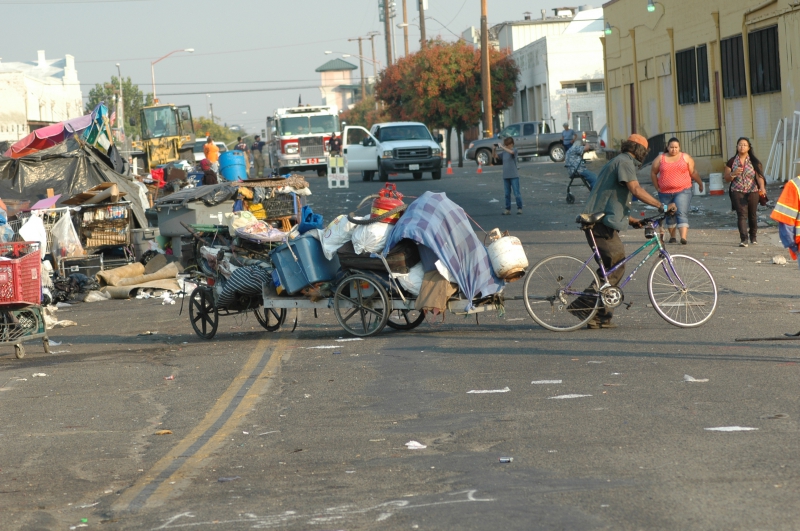
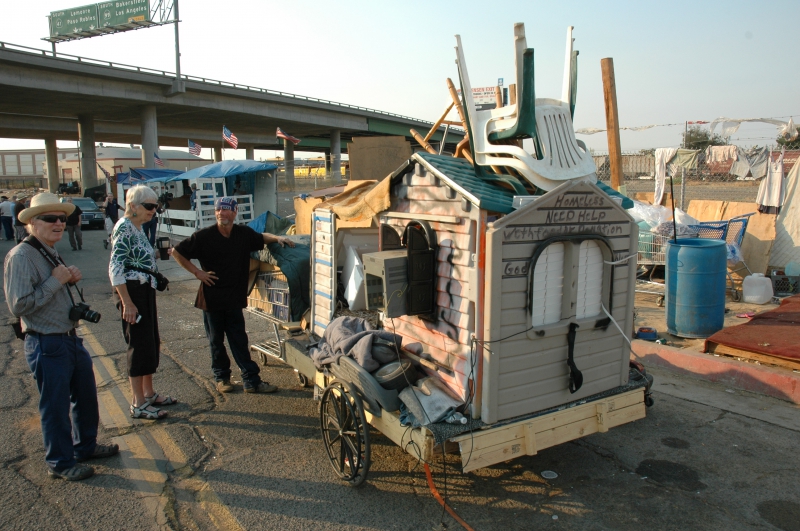
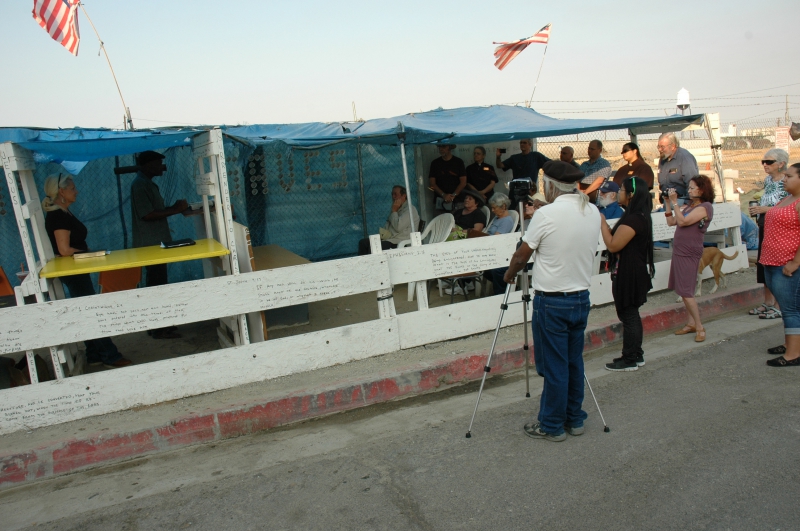

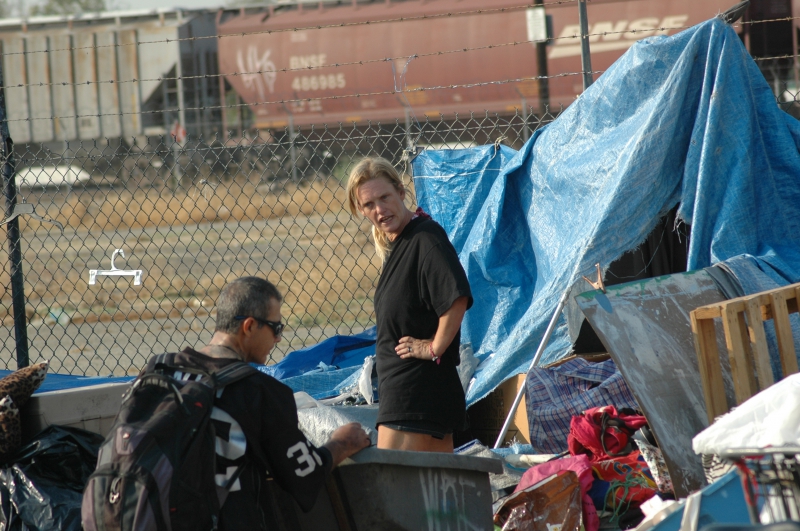
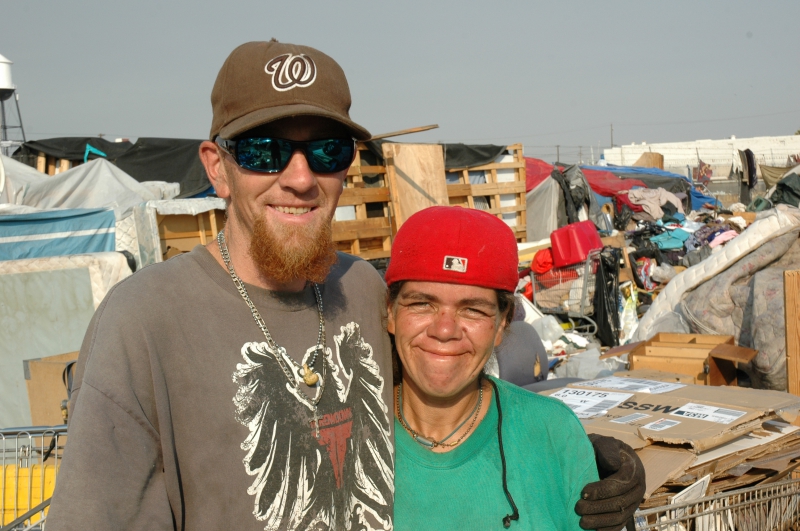
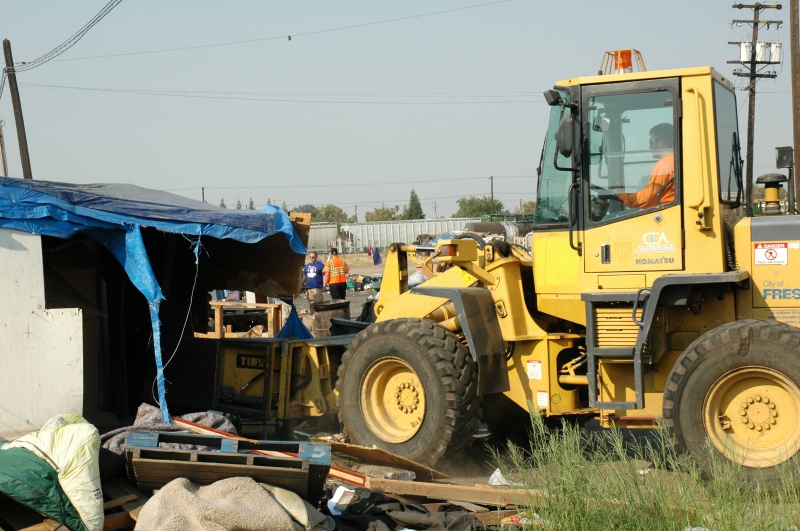
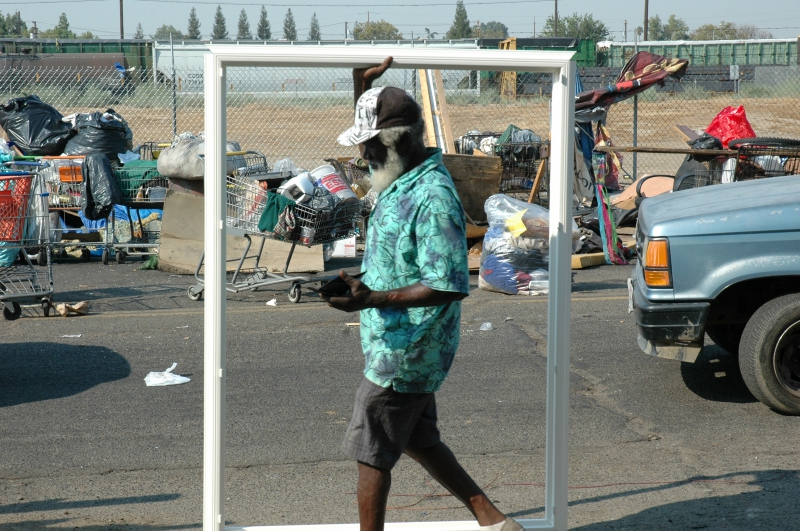
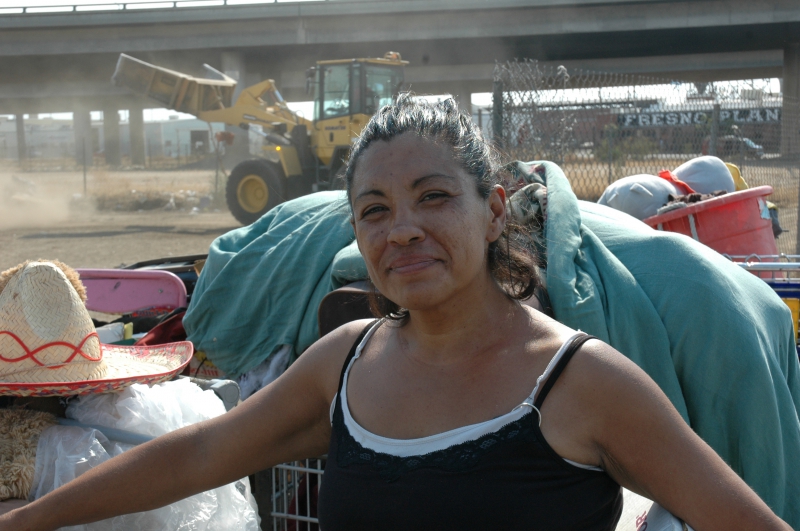
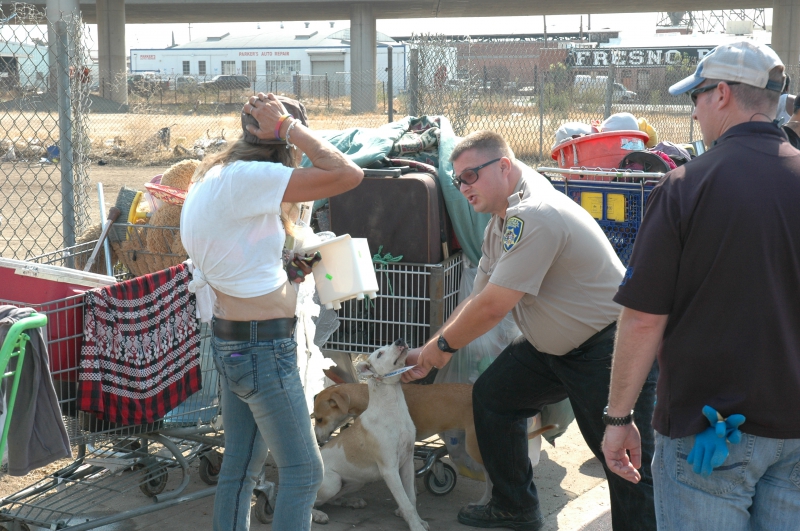
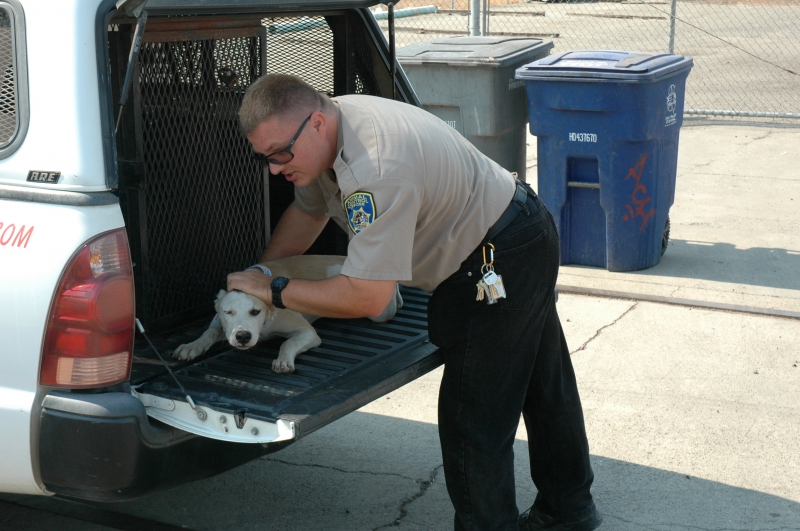







 The author, Jessie Speer (center), with Ray Polk (left) and Larry Collins (right) at the H street homeless encampment, which the City of Fresno plans to bulldoze on Sept. 9.
The author, Jessie Speer (center), with Ray Polk (left) and Larry Collins (right) at the H street homeless encampment, which the City of Fresno plans to bulldoze on Sept. 9.
 The City of Fresno destroyed Yellow Feather’s shelter and confiscated her property. She now sleeps on the sidewalk near the Poverello House.
The City of Fresno destroyed Yellow Feather’s shelter and confiscated her property. She now sleeps on the sidewalk near the Poverello House.
 Rev. Dr. Chris Breedlove of College Community Congregational spoke at the press conference organized by homeless advocates
Rev. Dr. Chris Breedlove of College Community Congregational spoke at the press conference organized by homeless advocates
